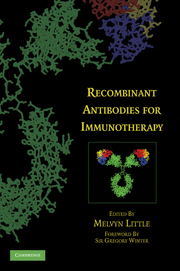Book contents
- Frontmatter
- Contents
- Contributors
- Foreword by Sir Gregory Winter
- Preface
- RECOMBINANT ANTIBODIES FOR IMMUNOTHERAPY
- PART I HUMANIZED ANTIBODIES
- PART II GENERATION AND SCREENING OF ANTIBODY LIBRARIES
- PART III TRANSGENIC HUMAN ANTIBODY REPERTOIRES
- PART IV ANTIBODY EFFECTOR FUNCTION
- 9 Mechanisms of Tumor Cell Killing by Therapeutic Antibodies
- 10 Optimization of Fc Domains to Enhance Antibody Therapeutics
- 11 Glycoengineered Therapeutic Antibodies
- PART V ARMING ANTIBODIES
- PART VI NOVEL ANTIBODY FORMATS
- PART VII ANTIGEN-BINDING REPERTOIRES OF NON-IMMUNOGLOBULIN PROTEINS
- PART VIII PROLONGATION OF SERUM HALF-LIFE
- PART IX INNOVATIVE IMMUNOTHERAPEUTIC APPROACHES
- PART X MARKET OVERVIEW AND OUTLOOK
- Index
- Plate section
- References
10 - Optimization of Fc Domains to Enhance Antibody Therapeutics
from PART IV - ANTIBODY EFFECTOR FUNCTION
Published online by Cambridge University Press: 15 December 2009
- Frontmatter
- Contents
- Contributors
- Foreword by Sir Gregory Winter
- Preface
- RECOMBINANT ANTIBODIES FOR IMMUNOTHERAPY
- PART I HUMANIZED ANTIBODIES
- PART II GENERATION AND SCREENING OF ANTIBODY LIBRARIES
- PART III TRANSGENIC HUMAN ANTIBODY REPERTOIRES
- PART IV ANTIBODY EFFECTOR FUNCTION
- 9 Mechanisms of Tumor Cell Killing by Therapeutic Antibodies
- 10 Optimization of Fc Domains to Enhance Antibody Therapeutics
- 11 Glycoengineered Therapeutic Antibodies
- PART V ARMING ANTIBODIES
- PART VI NOVEL ANTIBODY FORMATS
- PART VII ANTIGEN-BINDING REPERTOIRES OF NON-IMMUNOGLOBULIN PROTEINS
- PART VIII PROLONGATION OF SERUM HALF-LIFE
- PART IX INNOVATIVE IMMUNOTHERAPEUTIC APPROACHES
- PART X MARKET OVERVIEW AND OUTLOOK
- Index
- Plate section
- References
Summary
The Fc region of an antibody is the central link between the targeted antigen and the immune system. It is responsible for mediating a spectrum of effector functions that monoclonal antibodies (mAbs) use against tumors and pathogens. Whereas historically drug developers have kept the Fc region fixed, over the past decade there has been substantial effort to engineer it for improved effector function activity. This new direction has grown from a more mature understanding of the role of immune receptors in antibody therapy and the development of Fc modifications to control antibody/receptor interactions. In this chapter, we discuss how Fc engineering is being used to enhance antibody therapeutics for cellular effector functions, complement-mediated activities, and pharmacokinetic properties.
SITES FOR ENGINEERING AND OPTIMIZABLE PROPERTIES
The Fc region mediates binding of the antibody to all endogenous receptors other than target antigen. Although vaguely defined, an antibody's Fc region typically refers to the C-terminal portion of the hinge and the CH2 and CH3 domains, approximately residues 226 to the C-terminus using the EU numbering scheme. The human effector ligands that bind Fc can be divided into three groups (Figure 10.1): FcγRs, complement protein C1q, and the neonatal Fc receptor FcRn. The FcγRs all bind to essentially the same site on Fc, specifically the lower hinge and proximal CH2 region. Interaction with these receptors can elicit a variety of cellular effector functions that destroy target cells and regulate the immune system.
- Type
- Chapter
- Information
- Recombinant Antibodies for Immunotherapy , pp. 124 - 143Publisher: Cambridge University PressPrint publication year: 2009

